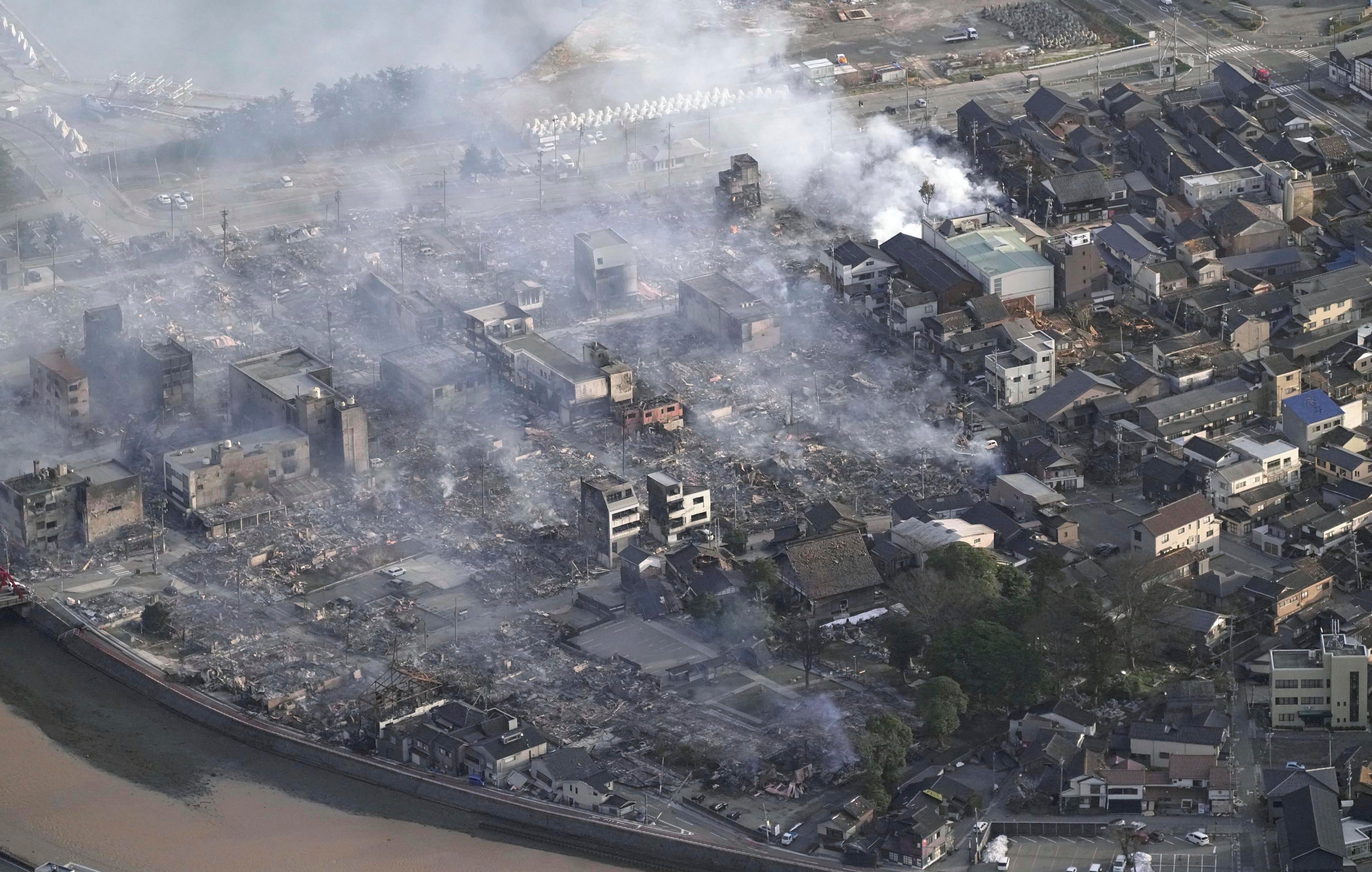Aerial photographs show scale of devastation after Japan earthquake
At least 48 dead and scores injured after powerful earthquake destroyed thousands of homes on New Year’s Day
Japanese rescue officials shared the first images on Tuesday showing the scale of devasation in the hard-to-reach areas worst hit by a massive 7.6-magnitude earthquake that triggered tsunami warnings across the region on New Year's Day.
The powerful quake struck the northern Ishikawa prefecture on Japan’s main central island of Honshu on Monday, prompting thousands of people in coastal regions to flee to higher ground as tsunami waves hit the western coast.
The death toll from the earthquake rose to 48 on Tuesday, officials said, as prime minister Fumio Kishida said rescuers faced a “battle against time” to reach the northern tip of the worst-hit Noto peninsula. Scores of others were still awaiting rescue, while 16 were confirmed injured in the quake.
Images showed smoke billowing from the site of an extensive fire that erupted following the earthquake in Wajima city, charring buildings and vehicles.

"The search and rescue of those impacted by the quake is a battle against time," Mr Kishida said during an emergency meeting that was itself interrupted by a significant aftershock registering as magnitude 5.6.
Rescuers were finding it very difficult to access the northern tip of the Noto peninsula where helicopter surveys had discovered many fires and widespread damage to buildings and infrastructure. Roads through mountain passes to reach the northern parts of Noto were cracked and rendered impassable.
At least 20 deaths were reported in Suzu city where at least 60 people were rushed to the hospital in the aftermath of the quake.
In the coastal town of just over 5,000 households near the quake’s epicentre, up to 1,000 houses may have been destroyed, said mayor Masuhiro Izumiya. “The situation is catastrophic,” he said.

There were 120 cases of people awaiting rescue, a government spokesperson said.
In Wajima, a seven-story building toppled over sideways while a central area known for its morning market was gutted by a large blaze. The city reported 19 deaths.

A massive blaze in the Kawaimachi district, which continued to burn on Tuesday, gutted over 100 structures, including shops and homes.
“I’ve never experienced a quake that powerful,” said Wajima resident Shoichi Kobayashi, 71, who was at home having a celebratory New Year’s meal with his wife and son when the quake struck.
“Even the aftershocks made it difficult to stand up straight,” he told Reuters, adding his family were sleeping in their car because they could not return to their badly damaged home.

Five more deaths were reported in Nanao city, where the quake triggered a landslide.

Around 200 tremors have been detected since the quake first hit on Monday, the Japan Meteorological Agency said, warning of more strong shocks in the coming days.
Chief cabinet secretary Yoshimasa Hayashi on Tuesday asked people in Japan to "be alert" for strong earthquakes up to magnitude seven for the next week.
"To the people that live in areas where the shake was strong, please look out for evacuation information through local offices, on TV, radio, and internet and take action accordingly,” he added.

The quake has significantly disrupted transportation in major parts of north and northwest Japan. About 500 people were stranded in a car park at the Noto airport as flight services were halted due to extensive damage to the runway and terminal building.
The government ordered around 100,000 people to evacuate their homes on Monday night. Almost half of those evacuated had returned to their homes on Tuesday after authorities lifted tsunami warnings.

Around 33,000 households still remained without power in Ishikawa prefecture on Tuesday after a night when temperatures dropped below freezing, according to Hokuriku Electric Power’s website. Nearly 20,000 homes had no water supply.
The Japanese government has been airlifting supplies to the affected region, but that effort was itself hit by tragedy on Tuesday evening after a Coast Guard plane carrying aid struck a Japan Airlines passenger jet at Tokyo’s Haneda airport, setting both planes on fire.
All 379 passengers and crew on the jumbo jet were evacuated safely, but five out of six Coast Guard crew on the other aircraft were killed. The Coast Guard team had been on their way to the Niigata airport base to deliver aid to the Noto peninsula, officials said.
Join our commenting forum
Join thought-provoking conversations, follow other Independent readers and see their replies
Comments
Bookmark popover
Removed from bookmarks